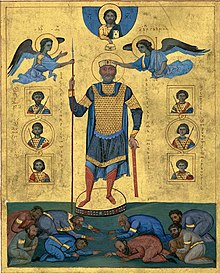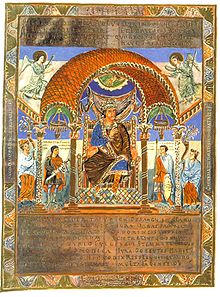
The Codex Manesse is a Liederhandschrift, the single most comprehensive source of Middle High German Minnesang poetry, written and illustrated between c. 1304 when the main part was completed, and c. 1340 with the addenda.
Judith of Swabia, a member of the Salian dynasty, was the youngest daughter of Emperor Henry III from his second marriage with Agnes of Poitou. By her two marriages she was Queen of Hungary from 1063 to 1074 and Duchess of Poland from 1089 to 1102.
Philip of Swabia, styled Philip II in his charters, was a member of the House of Hohenstaufen and King of Germany from 1198 until his assassination.

The Codex Aureus of St. Emmeram is a 9th-century illuminated Gospel Book. It takes its name from Saint Emmeram's Abbey, where it was for most of its history and is lavishly illuminated. The cover of the codex is decorated with gems and relief figures in gold, and can be precisely dated to 870, and is an important example of Carolingian art, as well as one of very few surviving treasure bindings of this date.

The Peace of Bautzen was a treaty concluded on 30 January 1018, between Holy Roman Emperor Henry II and Bolesław I of Poland which ended a series of Polish-German wars over the control of Lusatia and Upper Lusatia as well as Bohemia, Moravia and Slovakia.
Cunigunde of Luxembourg, OSB, also called Cunegundes, Cunegunda, and Cunegonda and, in Latin, Cunegundis or Kinigundis, was Empress of the Holy Roman Empire by marriage to Holy Roman Emperor Henry II. She ruled as interim regent after the death of her spouse in 1024. She is a saint and the patroness of Luxembourg; her feast day is 3 March.
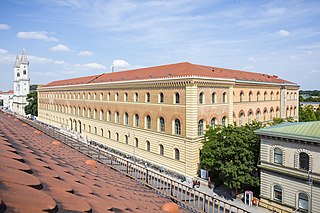
The Bavarian State Library in Munich is the central "Landesbibliothek", i. e. the state library of the Free State of Bavaria, the biggest universal and research library in Germany and one of Europe's most important universal libraries. With its collections currently comprising around 10.89 million books, it ranks among the leading research libraries worldwide. The Bayerische Staatsbibliothek furthermore is Europe's second-largest journals library. Furthermore, its historical holdings encompass one of the most important manuscript collections of the world, the largest collection of incunabula worldwide, as well as numerous further important special collections. Its collection of historical prints before 1850 totals almost one million units.

The Vyšehrad Codex, also known as the Coronation Gospels of King Vratislaus, is a late 11th-century illuminated Romanesque Gospel Book, which is considered the most important and most valuable manuscript kept in Bohemia. Its extremely rich iconography and its visual components rank it among the most precious illuminated manuscripts of the second half of the 11th century in Europe. It was probably made at the order of Czech diplomats to honour an anniversary of the Czech King Vratislav's coronation which took place in 1085. The codex is of Danubian provenance, and closely related to three other surviving manuscripts – two of them now in Poland and one in the Prague Chapter Library. They probably originated in the circle of the scriptorium at the Monastery of St. Emmeram in Regensburg. The manuscript is now located in the Czech National Library, Prague under the signature XIV A 13. In 2005 it was declared as a National cultural monument of the Czech Republic.

Ottonian art is a style in pre-romanesque German art, covering also some works from the Low Countries, northern Italy and eastern France. It was named by the art historian Hubert Janitschek after the Ottonian dynasty which ruled Germany and Northern Italy between 919 and 1024 under the kings Henry I, Otto I, Otto II, Otto III and Henry II. With Ottonian architecture, it is a key component of the Ottonian Renaissance. However, the style neither began nor ended to neatly coincide with the rule of the dynasty. It emerged some decades into their rule and persisted past the Ottonian emperors into the reigns of the early Salian dynasty, which lacks an artistic "style label" of its own. In the traditional scheme of art history, Ottonian art follows Carolingian art and precedes Romanesque art, though the transitions at both ends of the period are gradual rather than sudden. Like the former and unlike the latter, it was very largely a style restricted to a few of the small cities of the period, and important monasteries, as well as the court circles of the emperor and his leading vassals.

Saint Emmeram's Abbey was a Benedictine monastery founded around 739 at Regensburg in Bavaria at the grave of the itinerant Frankish bishop Saint Emmeram. The original abbey church is now a parish church named St. Emmeram's Basilica. The other buildings on the site form a large complex known as Schloss Thurn und Taxis or Schloss St. Emmeram, which has served as the main residence of the Thurn und Taxis princely family since the early 19th century.
Hermann III was a member of the Conradine dynasty. He was Duke of Swabia from 1003 until 1012.

Saint Emmeram of Regensburg was a Christian bishop and a martyr born in Poitiers, Aquitaine. Having heard of idolatry in Bavaria, Emmeram travelled to Ratisbon (Regensburg) some time after the year 649 to the court of Theodo I, Duke of Bavaria. He supposedly travelled up the Loire, crossed through the Black Forest and then followed the Danube to Regensburg. Theodo welcomed Emmeram to his court, where he laboured for three years carrying out missionary work. During this time, he gained a reputation as a pious man. He died circa 652 and is buried in St. Emmeram's in Regensburg, Germany. His feast day in the Catholic Calendar of saints is September 22.
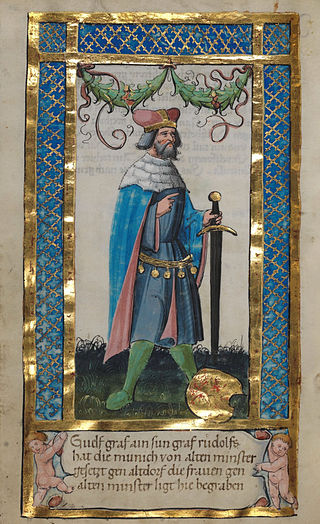
Welf II was a Swabian count and a member of the Elder House of Welf.
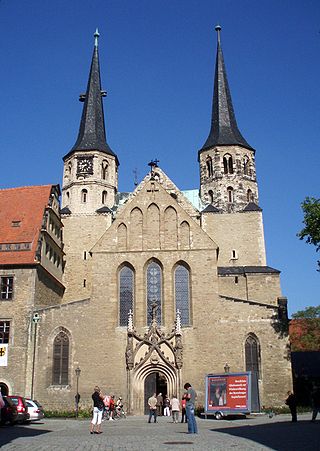
Merseburg Cathedral is the proto-cathedral of the former Bishopric of Merseburg in Merseburg, Germany. The mostly Gothic church is considered an artistic and historical highlight in southern Saxony-Anhalt.

Michaelsberg Abbey or Michelsberg Abbey, also St. Michael's Abbey, Bamberg is a former Benedictine monastery in Bamberg in Bavaria, Germany. After its dissolution in 1803 the buildings were used for the almshouse Vereinigtes Katharinen- und Elisabethen-Spital, which is still there as a retirement home. The former abbey church remains in use as the Michaelskirche.

Henry V was King of Germany and Holy Roman Emperor, as the fourth and last ruler of the Salian dynasty. He was made co-ruler by his father, Henry IV, in 1098.
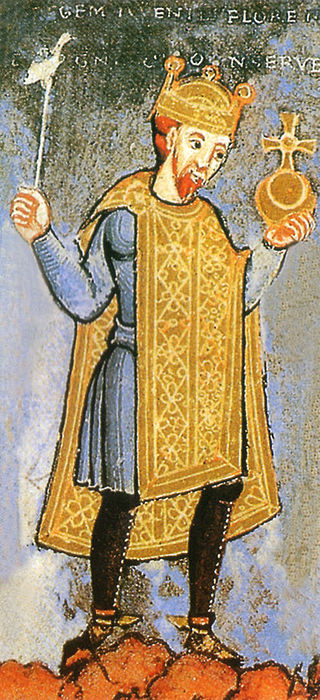
Henry III, called the Black or the Pious, was Holy Roman Emperor from 1046 until his death in 1056. A member of the Salian dynasty, he was the eldest son of Conrad II and Gisela of Swabia.
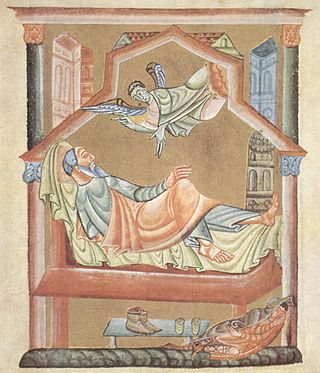
The Seeon Evangeliary or Evangeliary of Henry II is an evangeliary created at Seeon Abbey between 1002 and 1014. Today it is kept in the Bamberg State Library under the record number Msc. Bibl. 95)

The Great Gandersheim Conflict was a conflict between the Archbishops of Mainz and the Bishops of Hildesheim concerning the jurisdiction over Gandersheim Abbey. It lasted from 987 to 1030, during the reign of the Ottonian emperors Otto III and Henry II as well as of their Salian successor Conrad II.

Stefan Weinfurter was a German historian who researched the history of the Early and High Middle Ages.


